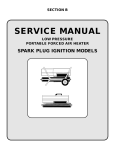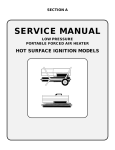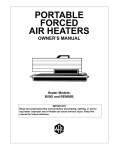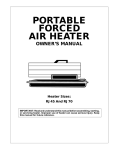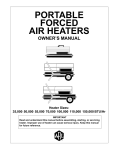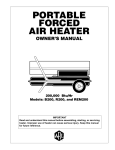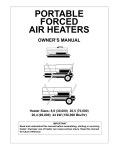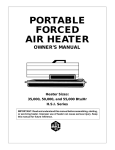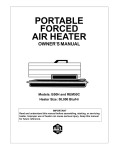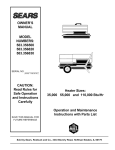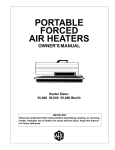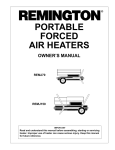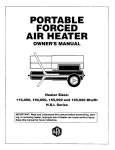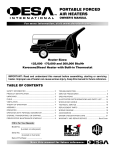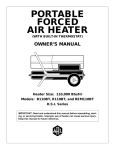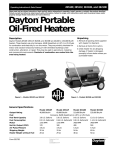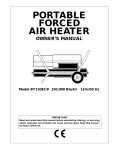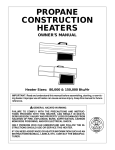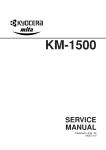Download SERVICE MANUAL
Transcript
SECTION A SERVICE MANUAL LOW PRESSURE PORTABLE FORCED AIR HEATER HOT SURFACE IGNITION MODELS Hot Surface Ignition Models Service Manual SAFETY INFORMATION WARNINGS IMPORTANT: Read this owner’s manual carefully and completely before trying to assemble, operate, or service this heater. Improper use of this heater can cause serious injury or death from burns, fire, explosion, electrical shock, and carbon monoxide poisoning. • • • DANGER: Carbon monoxide poisoning may lead to death! Carbon Monoxide Poisoning: Early signs of carbon monoxide poisoning resemble the flu, with headaches, dizziness, and/ or nausea. If you have these signs, the heater may not be working properly. Get fresh air at once! Have heater serviced. Some people are more affected by carbon monoxide than others. These include pregnant women, persons with heart or lung disease or anemia, those under the influence of alcohol, and those at high altitudes. Make certain you read and understand all warnings. Keep this manual for reference. It is your guide to safe and proper operation of this heater. • Use only kerosene or No. 1 fuel oil to avoid risk of fire or explosion. Never use gasoline, naphtha, paint thinners, alcohol, or other highly flammable fuels. • Fueling a)Personnel involved with fueling shall be qualified and thoroughly familiar with the manufacturer’s instructions and applicable federal, state, and local regulations regarding the safe fueling of heating units. b)Only the type of fuel specified on the heater’s data plate shall be used. c)All flame, including the pilot light, if any, shall be extinguished and the heater allowed to cool, prior to fueling. d)During fueling, all fuel lines and fuel-line connections shall be inspected for leaks. Any leaks shall be repaired prior to returning the heater to service. e)At no time shall more than one day’s supply of heater fuel be stored inside a building in the vicinity of the heater. Bulk fuel storage shall be outside the structure. f) All fuel storage shall be located a minimum of 25 feet from heaters, torches, welding equipment, and similar sources of ignition (exception: the fuel reservoir integral with the heater unit). g)Whenever possible, fuel storage shall be confined to areas where floor penetrations do not permit fuel to drip onto or be ignited by a fire at lower elevation. • • • • • • • • • • • • • • • • 2 h)Fuel storage shall be in accordance with the federal, state, or local authority having jurisdiction. Never use heater where gasoline, paint thinner, or other highly flammable vapors are present. Follow all local ordinances and codes when using heater. Heaters used in the vicinity of tarpaulins, canvas, or similar enclosure materials shall be located a safe distance from such materials. The recommended minimum safe distance is 10 feet. It is further recommended that these enclosure materials be of a fire retardant nature. These enclosure materials shall be securely fastened to prevent them from igniting or from upsetting the heater due to wind action. Use only in well-vented areas. Before using heater, provide at least a three-square-foot opening of fresh, outside air for each 100,000 Btu/Hr of rating. This heater produces carbon monoxide, which is listed by the State of California as a reproductive toxin under Proposition 65. Use only in places free of flammable vapors or high dust content. Use only the electrical voltage and frequency specified on model plate. Use only a three-prong, grounded extension cord. Minimum heater clearances from combustibles: Outlet: 8 Ft. Sides: 4 Ft. Top: 4 Ft. Rear: 4 Ft. Locate heater on a stable and level surface if heater is hot or running or a fire may occur. When moving or storing heater, keep heater in a level position or fuel spillage may occur. Keep children and animals away from heater. Unplug heater when not in use. When used with thermostat, heater may start anytime. Never use heater in living or sleeping areas. Never block air inlet (rear) or air outlet (front) of heater. Never move, handle, refuel, or service a hot, operating, or plugged-in heater. Never attach duct work to front or rear of heater. Approved by the New York City Fire Department under certificate of approval #4803, #4860, #4908, or #4909. To be used only at construction sites in accordance with applicable New York City Codes, Regulations, Rules, Directives, Permits, etc. Warning to New York City Residents For Use Only At Construction Sites in accordance with applicable NYC codes under NYCFD certificate of approval #4803, #4899, #4908, #4909, or #4934. Hot Surface Ignition Models Service Manual TABLE OF CONTENTS GENERAL INFORMATION General Information I. ARRANGEMENT OF MANUAL I. II. III. IV. V. Arrangement of Manual ..................................... 3 Technical Service Department .......................... 3 Service Preparation ........................................... 3 Tools Required .................................................. 4 Parts .................................................................. 4 Specifications I. General Specifications 1. Fuel Selection ............................................... 5 2. Electrical ....................................................... 5 3. Ventilation ..................................................... 5 4. Heater Sizing ................................................ 5 II. Heater Performance Specifications ................... 6 Component Operation I. II. III. IV. V. Air System 1. Air Pump ....................................................... 7 2. Air Filters ...................................................... 7 3. Nozzle .......................................................... 7 Electrical System 1. Motors .......................................................... 7 2. Ignition Control/Photocell ............................. 8 3. Hot Surface Ignitor ....................................... 8 Fuel System ...................................................... 8 Combustion System .......................................... 9 All Systems Working Together .......................... 9 Troubleshooting I. Safety Requirements ....................................... 10 II. Cautions .......................................................... 10 III. Using The HA1170 Tester 1. Operation .................................................... 10 2. Calibration .................................................. 10 IV. Diagnostic Charts ............................................ 10 Wiring Diagrams ................................................. 23 This manual contains information and service procedures to assist the service technician in understanding and correcting problems on DESA International oil-fired portable forced air heaters. The first section of the manual contains basic information concerning the operation of the different components in the heater. This information should be reviewed by service personnel to provide a basic understanding of how the components function in the working system. The Troubleshooting section of this manual is intended to provide a quick reference concerning conditions which result in customer complaints. These procedures will help the service technician quickly diagnose a malfunctioning heater. The illustrations in this manual may not necessarily depict the actual heater model, and are intended for reference ONLY. II. TECHNICAL SERVICE DEPARTMENT The Technical Service Department, located in Bowling Green, Kentucky, is committed to assisting our Authorized Service Centers to increase their service knowledge, so that they can provide prompt, efficient service. This Service Manual covers the majority of problems that are associated with the heaters. However, as with any product, certain problems can arise which have not been covered. If such problems arise, please call the Technical Service Department's number, 1-800-323-5190, or visit our website at www.desatech.com, to address these technical problem areas. If you need assistance for ordering parts, billing questions, etc. you should contact 1-800-432-5212. III. SERVICE PREPARATION A clean work area at the start of each job is essential for efficient service work. Heaters which are extremely dirty should be cleaned prior to service. Cleaning will occasionally uncover the problem area. Tools needed for the job should be obtained before work is started. Delays resulting from locating tools result in lost time and wages. Clean fuel should always be used when testing heaters. Many problems are often traced to the use of the wrong type of fuel or dirty fuel. Use caution and common sense when working on a heater. Always remember that kerosene is flammable, and electrical parts can result in potential shock. Heater parts are hot during operation, which could result in burns. 3 Hot Surface Ignition Models Service Manual IV. TOOLS REQUIRED V. PARTS In addition to common hand tools, the service shop should have the following tools and instruments for proper repairing of the heaters. These instruments will be referred to throughout this manual. In addition to the standard parts we now offer parts kits. Listed below are the item numbers and the accessory description ITEM NUMBER ACCESSORY INSTRUMENT RANGE Control/Photocell Tester Pressure Gauge Feeler Gauge Multimeter N/A 0-15 P. S. I. .001 to .1 inch 0-250 VAC 0-200 Ohm HA1176A HA1180 HA1210 HA1202 HA2210 Parts Kit/All Models Air Gauge/All Models Thermostat/Forced Air & LP Forced Air Heavy Duty Wheel Kit Fits: 35, 40, 50, 55, 60, 70 Models Wheel Kit Fits: 35, 40, 50, 55, 60, 70 Models Rear Handle Fits: 110, 115 Models Rear Handle Fits: 150, 155, 165, 200 Models Filler Neck Screen ITEM NUMBER REPLACEMENT PART 104068-03 Ignition control Fits: 35, 40, 50, 55, 60 Models Ignition control Fits: 70, 110, 115, 150, 155, 165, 200 Models Rotor Kit 1/2" Nozzle (35, 40 Models) Nozzle (50/55 Models) Nozzle (60 Models) Nozzle (70 Models) Nozzle (110, 115 Models) Nozzle (150, 155 Models) Nozzle (165 Models) Nozzle (200 Models) Hot Surface Ignitor Air Filter Kit (35, 40, 50, 55, 60, 70 Models) Filter Kit (110, 115, 150, 155, 165, 200 Models) Rotor Kit 5/8" Photocell Pump Adjustment Kit PART NUMBER HA1170 HA1180 None* None** HA1206 *Available at any auto parts store. **Available at most electronic stores. .025 15 Feeler Gauge .00 HA1170 Control Tester HA2203 HA2204 104068-02 HA3004 HA3006 Refer to Owner’s Manual HA3024 HA3026 HA3027 HA3028 HA3029 100735-31 102548-03 HA3014 Pressure Gauge Multimeter HA3017 HA3005 M16656-24 HA3020 4 Hot Surface Ignition Models Service Manual SPECIFICATIONS 3. Ventilation I. GENERAL SPECIFICATIONS The heater should be used only in well-ventilated areas. As a rule, the following minimum requirements should be followed. 1. Fuel Selection HEATER SIZE (BTU) SQUARE FOOT OPENING One of the most critical specifications for trouble-free operation is the use of a clean, acceptable fuel. Listed below are guidelines and comments concerning operation of heaters with different fuels. 35,000/40,000 50,000/55,000/60,000 70,000 110,000/115,000 150,000/155,000 165,000 200,000 1.0 Sq. Ft. 1.6 Sq. Ft. 2.1 Sq. Ft. 3.2 Sq. Ft. 4.5 Sq. Ft. 5.0 Sq. Ft. 6.0 Sq. Ft. RECOMMENDED FUELS COMMENTS Kerosene Fuel Oil No.1 Jet "A" Best overall results. Minimum odor and minimum maintenance. No additives necessary for cold weather operation. ALTERNATE FUELS COMMENTS Fuel Oil No. 2 Diesel No. 1 Diesel No. 2 Noticeable increase in odor. Requires frequent maintenance of fuel filter and nozzle. Requires a winterizing additive at temperatures below 20°F 2. Electrical The heater must be connected to a standard electrical outlet (120V/60HZ). For safety, all heaters are equipped with a three prong power cord, which must be grounded. When selecting an extension cord for heater usage, the following chart should be used in determining wire size. LENGTH OF CORD WIRE SIZE (AWG) 100 Ft. 200 Ft. 300 Ft. 400 Ft. No. 14 No. 12 No. 10 No. 8 No. 6 The above is based on ventilation requirements of at least a 3 sq. ft. opening per 100,000 BTU. If possible, it is better to provide cross-ventilation to achieve better air movement. 4. Heater Sizing The user should be aware of the proper size heater needed for a particular application. It is easy to see that a 35,000 BTU heater would not heat a large warehouse, but the question is sometimes asked "What size heater should I use?" A simple formula that can be used to determine heater BTU requirements follows: Cu. Ft. of Area X .133 X Desired Temp. Rise °F = BTU Size Needed. Example: Area: 50' X 25' X 10' = 12,500 Cu. Ft. Desired Temp. Rise: 30°F 12,500 (Cu. Ft.) X .133 (Factor) 1662.5 X 30 (Temp. Rise) 49,875 (Proper Heater Size) 5 ANSWER: A 50,000 BTU heater should be selected for this application. Hot Surface Ignition Models Service Manual II. HEATER PERFORMANCE SPECIFICATIONS Technical Service Heater Performance Data Heater Model BTU Rating Pump PSI ± .1 Nozzle Part No. Nozzle GPH ± 5% Motor Part No. Motor Motor R.P.M. Horsepower R35D REM35C 35,000 3.0 100735-02 (HA3006) 0.30 100088-01 (102001-01) 1725 1/15 R40 REM40 40,000 3.0 100735-02 (HA3006) 0.30 100088-01 (102001-01) 1725 R55A REM55A 55,000 3.6 100735-17 (HA3024) 0.40 100088-01 (102001-01) R60 REM60 RM60 60,000 3.4 100735-17 (HA3024) 0.40 R70D R70DT 70,000 4.7 100735-18 (HA3026) R110B R110BT 110,000 5.3 R115 REM115 RM115 115,000 REM150E Fuel Tank Capacity (Gal) Hot Air Output (C.F.M.) AMPS (Running) 102548-03 104068-03 3.0 165 2.0 1/15 102548-03 104068-03 3.0 170 2.0 1725 1/15 102548-03 104068-03 5.0 175 2.0 100088-01 (102001-01) 1725 1/15 102548-03 104068-03 5.0 180 2.0 0.50 103609-01 (102001-20) 3450 1/8 102548-03 104068-02 5.0 250 2.8 100735-19 (HA3027) 0.80 103493-01 (102001-21) 3450 1/5 102548-03 104068-02 9.0 490 3.6 5.3 100735-19 (HA3027) 0.80 103493-01 (102001-21) 3450 1/5 102548-03 104068-02 9.0 490 3.6 150,000 5.4 100735-20 (HA3028) 1.10 103493-01 (102001-21) 3450 1/5 102548-03 104068-02 13.5 550 3.6 R155B REM155B RM155 155,000 5.4 100735-20 (HA3028) 1.10 103493-01 (102001-21) 3450 1/5 102548-03 104068-02 13.5 550 3.6 R165AT 165,000 5.6 100735-21 (HA3029) 1.20 103493-01 (102001-21) 3450 1/5 102548-03 104068-02 13.5 575 3.6 R200A 200,000 6.2 100735-31 1.40 105183-01 (102001-27) 3400 1/4 102548-03 104068-02 13.5 600 3.6 M16656-24 Photocell will apply to all models for service. 6 Ignitor Kit Control Board Hot Surface Ignition Models Service Manual COMPONENT OPERATION 3. Nozzle I. AIR SYSTEM 1. Air Pump The heater's air pump consists of a rotor with four carbon blades rotating inside a pump body. The rotor is driven directly by the motor and is attached to the motor shaft by means of a plastic insert. As the motor rotates, the carbon blades travel outward rubbing against the inside surface of the steel pump body. The rotor's position inside the pump body is such that it is not concentric with the pump body and a .003/.004 of an inch gap is set at the uppermost quadrant. As the motor rotates, the air between the blades is compressed and routed to the nozzle through the air line. Gap Adjusting Screw As mentioned previously, the purpose of the air pump is to compress air and deliver it to the nozzle. The compressed air, as it travels through the nozzle, creates a negative pressure that extends back through the center of the nozzle. This negative pressure lifts the fuel from the fuel tank. The fuel from the fuel tank and the compressed air are mixed at the nozzle which results in a very fine mist of fuel being sprayed into the combustion chamber. The air pump/nozzle combination eliminates the need for a conventional type fuel pump. It is important for the service technician to understand the nozzle operation. In many cases concerning improper operation of a heater, the problem is the result of a seal leak or a restriction (dust/dirt) being present within the nozzle. It should also be pointed out that each model heater requires different nozzles due to different fuel flow rates. .003/.004 Clearance Measured with Feeler Gage Motor Shaft Insert Compressed Air From Pump Air Intake Side Air Output Side Rotor Nozzle Face Pump Body Blade Fuel Lifted From Tank by Negative Pressure Direction of Rotation-Clockwise 2. Air Filters II. ELECTRICAL SYSTEM The air filtering system consists of an air input filter and an air output filter. The air input filter is located at the right rear of the motor and its purpose is to filter all incoming air prior to entering the air pump. The filter design is such that it can be cleaned in a mild, soapy solution, thoroughly dried and used over again. The air output filter is located under the plastic end cover. This filter's purpose is to prevent any carbon dust (from rotor or blade wear) from entering the air passages in the nozzle. This filter is non-cleanable and should be replaced when considerable buildup of carbon dust is observed. (See drawings below). 1. Motors Air Output Filter Air Output Filter Air Input Filter Air Input Filter The motors used on the low pressure heaters are fractional horsepower motors ranging from 1/15 HP on the smallest heater to 1/4 HP on the largest heaters. The motors used can be grouped into two categories. The first category is the shaded pole motor. The shaded pole motor contains a single winding and does not require an integral start/run capacitor for operation. This type of motor is used on 35, 40, 50, 55, and 60 model heaters. The second category is the permanent start capacitor motor. This motor contains two separate windings. The first winding being the auxiliary or start winding and the second being the main or run winding. This motor utilizes an integral start/run capacitor which is wired internally and cannot be replaced. This type of motor is used on the 70, 110, 115, 150, 155, 165, and 200,000 Btu models. X AU MOTOR 35,000, 50,000, 55,000, and 70,000 BTU Filter System AC LINE 110,000, 115,000, 150,000, 155,000, 165,000, and 200,000 BTU Filter System Shaded Pole Motor 7 CAPACITOR MA IN AC LINE Permanent Start Capacitor Motor Hot Surface Ignition Models Service Manual 2. Ignition Control/Photo Cell 3. Hot Surface Ignitor The ignition control circuit consists of a photocell (light sensitive resistor) and an ignition control. The photocell is used to sense the presence of light inside the combustion chamber. The resistance of the photocell changes as the light level inside the combustion chamber changes. When the heater is operating properly, the flame pattern inside the combustion chamber is very turbulent which results in the resistance of the photocell increasing and decreasing very rapidly. This dynamic change in resistance is required by the ignition control to allow the heater to continue to operate. If the signal from the photocell becomes “lazy” or steady state indicating a lack of turbulence, then the heater will be turned off. Some examples of this condition are a loss of fan and a blocked inlet. Because the photocell also responds to the color of the flame, the control will also shut off the heater if the fuel/air mixture is too lean. With a fuel lean mixture the flame becomes blue in color and the photocell does not respond to that end of the light spectrum as well as it responds to orange light which is present during proper operation. As a service technician, it is important to understand the operation of the ignition control. In the past, it has been the single most misdiagnosed part of the heater. It is suggested that all controls be checked per instructions listed in the Troubleshooting section, prior to replacement. All models will use 102548-03 Ignitor Kit. Photocell The hot surface ignitor is rated for 120 volts. With the rated voltage applied, the ignitor element heats up to 1400º Celsius (2550º Fahrenheit) within 5 seconds. When the atomized fuel is sprayed by the nozzle it is ignited by this extremely hot surface. Note: It is important for the service technician to be cautious when working with the hot surface ignitor due to its extremely high operating temperature. Care should also be taken not to bend or strike the ignitor element. Ignitor Block Ignitor Element III. FUEL SYSTEM (FUEL FILTERS) There are several types of fuel filters used on different model heaters. The filters are always located in line with the fuel pickup tube. The purpose of the filter is to eliminate the possibility of dirt, dust, etc. from entering the nozzle and restricting the flow. The filters should be inspected and cleaned whenever a heater is brought in for service. It is also important that the bottom of the tank be inspected for sedimentation or dirt buildup. The filter’s design is such that a possible restriction in the filter screen can be present during operation and be dislodged back into the tank when the heater is shut off. Ignition Control (mounted on side cover) 35, 40, 50, 55, 60, and 70,000 Btu Models 8 110, 115, 150, 155, and 165,000 Btu Models 200,000 Btu Model Hot Surface Ignition Models Service Manual IV. COMBUSTION SYSTEM V. ALL SYSTEMS WORKING TOGETHER Air being blown by the fan is directed by the air deflectors into the combustion chamber through the two louvers and center opening in the rear head which is riveted to the back of the combustion chamber. The nozzle and nozzle adapter are mounted in the burner strap which is fastened to the rear head. As the atomized fuel exits the nozzle and is ignited it mixes with the air entering through the rear head. The combustion process is completed inside the combustion chamber and the hot air exits the outlet end of the chamber. There are four basic systems within the heater: the fuel system, the air system, the electrical system, and the combustion system. An air pump (A) on one end of the motor shaft forces air through the air line (G) and out the nozzle (I). The moving air creates a pressure differential in the nozzle adapter (N) causing fuel to be drawn from the tank (J). The fuel-air mixture is sprayed into the combustion chamber (L) in a fine mist. Additional air is supplied to the combustion chamber by a fan (O) to enter the combustion chamber where it mixes with the air and fuel from the nozzle. The remaining air is directed around and over the combustion chamber. This air mixes with the heated air from the combustion chamber and is ejected as a jet of clean, heated air (K). The ignition system consists of an ignition control assembly (E) and hot surface ignitor (M). The ignition control assembly applies 120 volt power to the hot surface ignitor for 10 seconds which consists of a 5 second preheat period and a 3 to 4 second ignition trial period. The extremely high temperature of the ignitor element ignites the fuel and air mixture within the combustion chamber. After the trial period the power is removed from the ignitor. Air Deflector In the safety circuit, the photocell monitors the amount of flame turbulence inside the combustion chamber. Fan L N M A O K J I Air For Fuel System 9 G Air For Combustion E Fuel Hot Surface Ignition Models Service Manual TROUBLESHOOTING Calibration I. SAFETY REQUIREMENTS IMPORTANT: This tester will not function properly without adequate battery power. Prior to using the tester, the full load battery voltage must be verified as follows. This service manual is intended for use by individuals with an adequate knowledge of electrical and mechanical skills. Attempts to repair this heater by individuals without those skills can result in personal injury, as well as property damage. II. CAUTIONS 1. Before servicing, disconnect the heater from the electrical power source by removing the electrical plug from the wall receptacle. Note: When certain tests require electrical power to be applied, connect electrical power only for the time necessary to complete the test. 2. Do not bypass safety devices except when instructed to do so during troubleshooting procedures. 3. If replacement parts are necessary, do not substitute with non-factory parts (use only factory authorized replacement parts). 4. Make sure all electrical connections are secure and correct prior to connecting heater to a grounded electrical power source. Remove the battery cover to expose the battery and terminals. With the battery connected and the switch in the ON position (LED on continuous), measure the D.C. voltage across the battery terminals. If this voltage reads 7.5 volts or higher, proceed with testing. If the voltage reads lower than 7.5 volts, replace the battery and confirm the full load voltage. Battery Cover III. USING THE HA1170 TESTER The HA1170 control/photocell tester provides a means of troubleshooting the forced air kerosene heater by verifying the operation of the ignition control and photocell. Operation The tester’s toggle switch has three positions. The middle position puts the tester in the OFF mode. The switch should be kept here when the tester is not in use to conserve battery power. With the switch in the ON position, the red LED is on continuous. This 2 foot-candle light source can be used to test the static resistance of the photocell. With the switch in the PULSE position, the red LED flashes off and on at a rate of 10 times per second (10 hertz). This position is used to verify the proper operation of the ignition control. Toggle Switch Battery Battery Terminals IV. DIAGNOSTIC CHARTS The following pages contain various diagnostic charts. To use the charts, find the "Observed Fault" that exists and follow test procedure. Observed Fault Index Motor starts and runs but fuel does not ignite ................. 11 Ignitor element heats up but motor does not start within five seconds ................................................................... 14 Ignitor does not heat up and motor does not start within five seconds ........................................................................... 17 Ignitor heats up, motor starts and runs, and fuel ignites, but heater shuts off after a short period of time .................... 18 Delayed Ignition .............................................................. 22 Test Leads LED Light HA1170 Tester 10 Hot Surface Ignition Models Service Manual OBSERVED FAULT Motor Starts and Runs but Fuel Does Not Ignite Does Ignitor Element Heat Up? Yes No WARNING: High Voltage! 1 3 Check for Proper Pump Pressure Check for Defective Ignitor Check for Restricted Fuel Flow Due to: A. Seal leak B. Restriction in Nozzle or Nozzle Adapter C. Defective Solenoid Valve (200,000 Btu Models Only) Fuel Filter Restriction 4 2 Defective Ignition Control Assembly 5 TEST PROCEDURE 1 Check Ignitor Disconnect ignitor wires from ignition control assembly. Measure the resistance of the ignitor at the terminals with an ohmmeter (use 0-200 OHM scale). Ignitor resistance should measure 30 to 175 OHMS. If resistance measures outside of this range, then ignitor is defective and should be replaced. 2 Check Ignition Control Assembly Remove fuse cover and check fuse (70,000 to 200,000 Btu models only). If fuse is blown replace it with a GMA10 fuse. Disconnect motor red and white wires from control. With Ignitor wires disconnected, attach voltmeter leads to the ignitor terminals (labeled IGNITOR). Use the 0 to 200 V.A.C. scale. Plug power cord into a grounded 120V/60 Hz outlet. Meter should read 120V(rms) for approximately 10 seconds. If voltage reads 0 or stays at 120 for more than 10 seconds, the control is defective and should be replaced. Ignition Control WARNING: High Voltage! 11 Hot Surface Ignition Models Service Manual 3 Check for Proper Pump Pressure 4 Check for Restricted Fuel Flow Install HA1180 Pressure Gauge or equivalent to rear of air filter housing. Start heater and adjust air pressure to specified pressure. Turn adjustment screw clockwise to increase pressure and counterclockwise to decrease pump pressure. The screwdriver must be removed from the slot after any adjustment before taking a reading on the gauge. (See Heater Performance Specification on page 6 for specified pressures). Note: Pressure gauge must be scaled in 1/4 pound increments for accurate measurement. 35,000 to 165,000 Btu Models Remove air and fuel lines from nozzle adapter. Remove nozzle adapter/nozzle from bracket. 200,000 Btu Model Remove ignitor (do not strike or bend element) from bracket. Place in a safe location. Remove air and fuel lines from nozzle adapter. Remove two bracket screws and remove bracket, nozzle adapter, and nozzle assembly from combustion chamber. Using a 5/8" socket wrench, carefully remove the nozzle from nozzle adapter. (Be extremely careful not to scratch or score the face of the nozzle). A. Seal Leak Inspect nozzle seal or o-ring for damage. Replace if necessary. Combustion Chamber Nozzle/ Adapter Assembly Nozzle Face Nozzle Seal Nozzle Nozzle Adapter Air Line Fitting Fuel Line Fitting 35,000 - 165,000 Btu Models Nozzle Face Nozzle Seal Nozzle Adapter Nozzle Nozzle Adapter Bracket Air Line Fitting Fuel Line Fitting 200,000 Btu Models 12 Hot Surface Ignition Models Service Manual B. Restriction in Nozzle or Nozzle Adapter Using a compressed air source, blow the compressed air through the outlet end of nozzle to dislodge any foreign debris. 5 Fuel Filter Restriction The fuel filter should be inspected and cleaned (see section III, Fuel System (Fuel Filters), page 8. After removing filter, flush with clean kerosene in the reverse direction of the fuel flow. CAUTION: NEVER DRILL OUT OR TRY TO INCREASE NOZZLE SIZE. Fuel Filter, Bushing, and Lower Fuel Line Also, blow compressed air through the nozzle adapter in the direction shown to dislodge any foreign debris. Note: Fuel Filter Location May Vary According To Model. Refer to Fuel System, page 8. Fuel Flow Direction Flush In This Direction Blowing Compressed Air Through Nozzle 35,000 - 165,000 Btu Models 100,000 - 165,000 Btu Models Shown 200,000 Btu Models Blowing Compressed Air Through Nozzle Adapter C. Defective Solenoid Valve (200,000 Btu model only) Remove upper and lower fuel lines from fittings on solenoid valve. Apply 120V/60 Hz power to valve. Shine a flashlight at one side of valve. Light should be visible from the other side when the solenoid is energized. If not, the valve is obstructed or defective. Clean or replace as necessary. 13 Hot Surface Ignition Models Service Manual OBSERVED FAULT Ignitor Element Heats Up But Motor Does Not Start Within Five Seconds Rotate Fan by Hand to Determine if Fan Rotates Easily Fan Rotates Easily by Hand Fan is Difficult to Rotate 1 Broken Rotor or Blades 5 Open Motor Winding 2 Improper Rotor Clearance 6 Defective Ignition Control Assembly 3 Oversized Rotor 7 Defective Start/Run Capacitor 4 Dry Motor Bearing 8 Improper Voltage to Heater TEST PROCEDURE 1 Broken Rotor or Blades Gap Disassemble the end cover filter and end pump cover from rear of motor. Visually inspect the rotor and blades for breakage. Make sure that the rotor and blades are free of any type of lubricant. Rotor and blades must be clean and dry for proper operation. Blade 2 Improper Rotor Clearance Check rotor with feeler gauge for proper clearance (.003"-.004") between rotor and pump body. Rotate rotor and make sure all four quadrants of rotor have adequate clearance. Pump Body Rotor 3 Oversized Rotor If the fan is hard to turn when the motor end cover is installed, but easy to turn when loosened, the rotor should be removed and lightly sanded. Remove the rotor and lightly sand by placing rotor in the palm of hand and sanding on a flat surface making figure eight rotations. (Use the finest grade of sandpaper available). Sandpaper 14 Hot Surface Ignition Models Service Manual 4 Dry Motor Bearing If the fan is difficult to turn with air pump parts removed, then motor bearings are defective. Bearings are permanently lubricated, therefore motor should be replaced. 5 Open Motor Windings Disconnect motor wires (red and white) from ignition control assembly. Attach the ohmmeter leads to the moter wire terminals. Using the 0 to 200 OHM scale, measure the resistance of the motor windings. Refer to the chart below for resistances for each model. If the resistance is not within the specified range motor is defective and should be replaced. NOTE: Resistances may vary due to motor temperature. Note: Motor may vary according to model MOTOR WINDING RESISTANCE MODEL RESISTANCE RANGE (OHMS) 35,000, 50,000, 55,000, 60,000 5.57-6.81 70,000 6.03-7.37 100,000, 110,000, 150,000 155,000, 165,000 4.14-5.06 200,000 3.96-4.84 Note: In some cases it is possible for the resistance to read correctly without power applied and the motor still not work with power applied. If the ignition control assembly is tested and found to be good, then the motor is defective and should be replaced. 15 Hot Surface Ignition Models Service Manual 6 Defective Ignition Control Assembly Disconnect motor wires from control. Attach voltmeter leads to motor terminals on control. Use 0 to 200 V.A.C. scale on meter. Plug power cord into a 120V/60 Hz grounded outlet. Meter should read 0 volts for five seconds, 120 volts for 3 to 4 seconds, then drop to 0 volts. If the meter remains at 0 volts, the control is defective and should be replaced. 7 Defective Start/Run Capacitors Motors used in 70,000 to 200,000 Btu model heaters are the Permanent Start Capacitor (PSC) type and are equipped with an integral start/run capacitor. If the resistance of the motor windings read correctly and the ignition control assembly is found to be working properly, the capacitor may be "open" circuit. The capacitor is wired internally and cannot be replaced. No service parts are available and entire motor assembly should be replaced. 8 Improper Voltage Input to Heater The specified voltage operating range for this product is 108 to 132 volts (rms) 60 hertz. Verify that the voltage applied to the heater while the motor is running is at least 108 volts and does not exceed 132 volts. Refer to the Electrical section of this manual (page 5) for proper extension cord sizing. 16 Hot Surface Ignition Models Service Manual OBSERVED FAULT Ignitor Does Not Heat Up and Motor Does Not Start Within 5 Seconds Possible Causes External to Heater Possible Causes Internal to Heater Circuit Breaker is Tripped 1 Check for Broken or Frayed Wires on Power Cord or Extension Cord Bad Electrical Connection(s) or Wired Incorrectly 2 Blown Fuse on Ignition Control Assembly 3 Defective Ignition Control Assembly If External Thermostat is Used, Plug Heater Directly Into AC Source to Isolate Source of Problem power to control. Meter should read 0 volts for five seconds, 120 volts for 3 to 4 seconds, then drop to 0 volts. If measurements differ from those described, control is defective and should be replaced. TEST PROCEDURE 1 Bad Electrical Connection(s) or Wired Incorrectly Verify that all connections to the ignition control assembly are secure and wired according to the wiring diagram on page 23. Ignitor Motor Fuse Clips Motor Ignitor Fuse Checking Fuse 2 Blown Fuse on Ignition Control Assembly Remove fuse cover and inspect fuse. Check for continuity with an ohmmeter. If fuse is open, replace with a fuse of the same type and rating (GMA-10). 3 Defective Ignition Control Assembly With motor and ignitor wires disconnected, connect voltmeter leads to the ignitor terminals. Use the 0 to 200 V.A.C. scale on the voltmeter. Apply power (120V/60Hz) to the control. The meter should read 120 volts for ten seconds and then drop to 0 volts. Remove power to control. Connect meter leads to the motor terminals. Apply Meter Leads 17 Hot Surface Ignition Models Service Manual OBSERVED FAULT Ignitor Heats Up, Motor Starts and Runs, and Fuel Ignites, But Heater Shuts Off After a Short Period of Time Safety Control Trips out After Ten Seconds of Operation Ignition Control Trips out Within the First Ten Seconds of Operation 1 Defective Ignition Control 2 Defective or Dirty Photocell 3 Bad Electrical Connection(s) or Wired Incorrectly 4 Photocell Boot Not Properly Seated in Bracket 5 Check for proper Pump Pressure 6 Dirty/Clogged Filters in Compressor 7 Check for Restricted Fuel Flow Due to: A. Seal Leak B. Filter Blocked C. Restriction in Nozzle or Nozzle Adapter 8 Fuel Cap and Gasket Not Vented TEST PROCEDURE Toggle Switch 1 Defective Ignition control Remove pressure gauge plug from filter end cover. Remove 4 side cover screws that attach the side cover to the heater. Allow side cover (with ignition control attached) to rest on fuel tank flange. Disconnect only the photocell wires from ignition control. Attach the HA1170 leads to the photocell terminals on the ignition control. Plug the power cord into a grounded 120V/60 Hz outlet. When the motor starts turn the HA1170 toggle switch to the "flashing" red LED position (see page 10 for HA1170 calibration procedures). If the motor shuts off after 3 or 4 seconds, the control is defective and should be replaced. If the motor continues to run in step 1, the photocell may be dirty or defective. Flashing Red LED Test Leads Photocell Ends 18 Hot Surface Ignition Models Service Manual 2 Defective or Dirty Photocell Assembly Inspect the lens of the photocell for soot/dirt, etc... If dirty, wipe off with a clean, damp cloth. Remove photocell assembly from heater. Turn the toggle switch on the HA1170 tester to the "solid" red LED position. Place the photocell boot over the red LED on the tester. Connect the leads of an ohmmeter to the terminals on the photocell assembly. Use the 0 to 20,000 OHM scale on the meter. The resistance should measure 11,000 OHMS or less. If not the photocell is defective and should be replaced. Block off the light source by putting thumb over opening of photocell. Replace the photocell if a change in resistance is not observed. The resistance should measure greater than 50,000 OHMS (use the 1 megohm scale on the meter). 3 Bad Electrical Connection(s) or Wired Incorrectly Verify that all electrical connections are secure and making electrical contact. Verify that wiring is per the wiring diagram (see diagram, page 23). 4 Photocell Boot Not Properly Seated in Bracket Make sure photocell boot is seated in bracket securely. See illustration that follows. Photocell Correct Photocell Placement Photocell Incorrect Photocell Placement 19 Hot Surface Ignition Models Service Manual 5 Check for Proper Pump Pressure 6 Dirty/Clogged Air Filters in Compressor Inspect and replace air intake, air output, and lint filter if necessary. Filters should be replaced after 500 hours of operation. Install HA1180 Pressure Gauge or equivalent to rear of air filter housing. Start heater and adjust air pressure to specified pressure. Turning adjustment screw clockwise increases pressure, counterclockwise decreases pressure. The screwdriver must be removed from the slot after any adjustment before taking a reading on the gauge. (See Heater Performance Specification, on page 6 for specified pressures). It may be necessary to connect the HA1170 tester in place of the photocell while adjusting the pressure due to the fast shutdown response of the control. Note: Pressure gauge must be scaled in 1/4 pound increments for accurate measurement. Blade Pump Plate Air Intake Filter Insert Rotor HA1180 Pressure Gauge Air Output Filter Fan Guard Flat Blade Screwdriver Adjustment Screw 20 Filter End Cover Hot Surface Ignition Models Service Manual 8 Fuel Cap and Gasket Not Vented 7 Check for Restricted Fuel Flow Remove fuel cap and inspect the vent hole and gasket to make sure the passage is open. Verify that only one gasket has been installed. The fuel tank must be vented properly for the fuel delivery system to operate correctly. 35,000 to 165,000 Btu Models Remove air and fuel lines from nozzle adapter. Remove nozzle adapter/nozzle from bracket. 200,000 Btu Model Remove ignitor (do not strike or bend element) from bracket. Place in a safe location. Remove air and fuel lines from nozzle adapter. Remove two bracket screws and remove bracket, nozzle adapter and nozzle assembly from combustion chamber. Using a 5/8" socket wrench, carefully remove the nozzle from nozzle adapter. (Be extremely careful not to scratch or score the face of the nozzle). A. Seal Leak Inspect nozzle seal or o-ring for damage. Replace if necessary. Combustion Chamber Nozzle/ Adapter Assembly Nozzle Face Nozzle Seal Nozzle Nozzle Adapter Air Line Fitting Fuel Line Fitting 35,000 - 165,000 Btu Models Nozzle Face Nozzle Seal Nozzle Adapter Nozzle Nozzle Adapter Bracket Air Line Fitting Fuel Line Fitting 200,000 Btu Models 21 Hot Surface Ignition Models Service Manual OBSERVED FAULT Delayed Igniton 1 Wrong Fuel 2 Contaminated or Old Fuel TEST PROCEDURE 1 Wrong Fuel Refer to Fuel Selection on page 5 of this manual. 2 Contaminated or Old Fuel Fuel may not be fresh or may be contaminated with water or other foreign liquids. Drain fuel tank and rinse with clean, fresh kerosene or No. 1 fuel oil. Refer to local city or county ordinances for proper disposal of fuel oil. 22 Hot Surface Ignition Models Service Manual WIRING DIAGRAMS White 102350-01 (104068-01 Kit) Ignition Control Assembly AC Neutral (L2) Photocell Blue Photocell Blue Photocell Green White Motor Return Green Ignitor Motor Motor Red AC Hot (L1) Black ATTENTION: Earth ground must be connected to ensure operator safety! Power Plug 120V/60Hz Ignitor Gray Ignitor Gray 55,000 BTU Model (R55A Model Only) Blue Photocell Blue Photocell White Ignitor Motor 120V (L1) Red Motor Black Black Green AC Neutral (L2) Power Plug 120V/60Hz Green White Motor Return Yellow (-01) Gray (-02) Ignition Control Assembly 104040-01/02 (104068-02/03 Kit) Photocell If Equipped With Built-In Thermostat Thermostat Ignitor Ignitor Yellow (-01) Gray (-02) 35,000, 40,000, 50,000, 55,000, 60,000, 70,000, 110,000, 115,000, 150,000, 155,000, 165,000 BTU Models Blue Photocell Ignitor White Motor Return Solenoid Valve AC Hot (L1) Thermostat Red White Green Ignitor If Equipped With Built-In Thermostat Motor Red Motor Black Black White Green AC Neutral (L2) Power Plug 120V/60Hz White Black Ignition Control Assembly 104040-01 (104068-02 Kit) Photocell Blue Photocell Red Black Ignitor 200,000 BTU Model 23 Technical Service Department P.O. Box 90004 2701 Industrial Drive Bowling Green, Kentucky 42102 www.desatech.com SECTION B SERVICE MANUAL LOW PRESSURE PORTABLE FORCED AIR HEATER SPARK PLUG IGNITION MODELS Spark Plug Ignition Models Service Manual SAFETY INFORMATION WARNINGS IMPORTANT: Read this owner’s manual carefully and completely before trying to assemble, operate, or service this heater. Improper use of this heater can cause serious injury or death from burns, fire, explosion, electrical shock, and carbon monoxide poisoning. • • • DANGER: Carbon monoxide poisoning may lead to death! Carbon Monoxide Poisoning: Early signs of carbon monoxide poisoning resemble the flu, with headaches, dizziness, and/ or nausea. If you have these signs, the heater may not be working properly. Get fresh air at once! Have heater serviced. Some people are more affected by carbon monoxide than others. These include pregnant women, persons with heart or lung disease or anemia, those under the influence of alcohol, and those at high altitudes. Make certain you read and understand all warnings. Keep this manual for reference. It is your guide to safe and proper operation of this heater. • Use only kerosene or No. 1 fuel oil to avoid risk of fire or explosion. Never use gasoline, naphtha, paint thinners, alcohol, or other highly flammable fuels. • Fueling a) Personnel involved with fueling shall be qualified and thoroughly familiar with the manufacturer’s instructions and applicable federal, state, and local regulations regarding the safe fueling of heating units. b) Only the type of fuel specified on the heater’s data plate shall be used. c) All flame, including the pilot light, if any, shall be extinguished and the heater allowed to cool, prior to fueling. d) During fueling, all fuel lines and fuel-line connections shall be inspected for leaks. Any leaks shall be repaired prior to returning the heater to service. e) At no time shall more than one day’s supply of heater fuel be stored inside a building in the vicinity of the heater. Bulk fuel storage shall be outside the structure. f) All fuel storage shall be located a minimum of 25 feet from heaters, torches, welding equipment, and similar sources of ignition (exception: the fuel reservoir integral with the heater unit). g) Whenever possible, fuel storage shall be confined to areas where floor penetrations do not permit fuel to drip onto or be ignited by a fire at lower elevation. • • • • • • • • • • • • • • • • 2 h) Fuel storage shall be in accordance with the federal, state, or local authority having jurisdiction. Never use heater where gasoline, paint thinner, or other highly flammable vapors are present. Follow all local ordinances and codes when using heater. Heaters used in the vicinity of tarpaulins, canvas, or similar enclosure materials shall be located a safe distance from such materials. The recommended minimum safe distance is 10 feet. It is further recommended that these enclosure materials be of a fire retardant nature. These enclosure materials shall be securely fastened to prevent them from igniting or from upsetting the heater due to wind action. Use only in well-vented areas. Before using heater, provide at least a three-square-foot opening of fresh, outside air for each 100,000 Btu/Hr of rating. This heater produces carbon monoxide, which is listed by the State of California as a reproductive toxin under Proposition 65. Use only in places free of flammable vapors or high dust content. Use only the electrical voltage and frequency specified on model plate. Use only a three-prong, grounded extension cord. Minimum heater clearances from combustibles: Outlet: 8 Ft. Sides: 4 Ft. Top: 4 Ft. Rear: 4 Ft. Locate heater on a stable and level surface if heater is hot or running or a fire may occur. When moving or storing heater, keep heater in a level position or fuel spillage may occur. Keep children and animals away from heater. Unplug heater when not in use. When used with thermostat, heater may start anytime. Never use heater in living or sleeping areas. Never block air inlet (rear) or air outlet (front) of heater. Never move, handle, refuel, or service a hot, operating, or plugged-in heater. Never attach duct work to front or rear of heater. Approved by the New York City Fire Department under certificate of approval #4803, #4860, #4908, or #4909. To be used only at construction sites in accordance with applicable New York City Codes, Regulations, Rules, Directives, Permits, etc. Warning to New York City Residents For Use Only At Construction Sites in accordance with applicable NYC codes under NYCFD certificate of approval #4803, #4899, #4908, #4909, or #4934. Spark Plug Ignition Models Service Manual TABLE OF CONTENTS GENERAL INFORMATION General Information I. ARRANGEMENT OF MANUAL I. II. III. IV. V. Arrangement of Manual ..................................... 3 Technical Service Department .......................... 3 Service Preparation ........................................... 3 Tools Required .................................................. 4 Parts .................................................................. 4 Specifications I. General Specifications 1. Fuel Selection ............................................... 5 2. Electrical ....................................................... 5 3. Ventilation ..................................................... 5 4. Heater Sizing ................................................ 6 Heater Performance Specifications ................... 6 Component Operation I. II. III. IV. V. Air System 1. Air Pump ....................................................... 7 2. Air Filters ...................................................... 7 3. Nozzle .......................................................... 7 Electrical System 1. Motors .......................................................... 7 2. Solid State Relay .......................................... 8 3. Safety Control/Photocell ............................... 8 4. Electronic Ignitor ........................................... 9 Fuel System ...................................................... 9 Combustion System .......................................... 9 All Systems Working Together .......................... 9 Troubleshooting I. Safety Requirements ....................................... 10 II. Cautions .......................................................... 10 III. Using the Ohmmeter 1. Setting Up the Ohmmeter ........................... 10 2. Calibration .................................................. 10 IV. Diagnostic Charts ............................................ 10 Diagrams and Charts I. Wiring Diagrams .............................................. 23 II. Motor Resistance Chart .................................. 23 This manual contains information and service procedures to assist the service technician in understanding and correcting problems on DESA International oil-fired portable forced air heaters. The first section of the manual contains basic information concerning the operation of the different components in the heater. This information should be reviewed by service personnel to provide a basic understanding of how the components function in the working system. Section four of this manual is intended to provide a quick reference concerning conditions which result in customer complaints. These procedures will help the service technician quickly diagnose a malfunctioning heater. The illustrations in this manual may not necessarily depict the actual heater model, and are intended for reference ONLY. II. TECHNICAL SERVICE DEPARTMENT The Technical Service Department, located in Bowling Green, Kentucky, is committed to assisting our Authorized Service Centers to increase their service knowledge, so that they can provide prompt, efficient service. This Service Manual covers the majority of problems that are associated with the heaters. However, as with any product, certain problems can arise which have not been covered. If such problems arise, please call the Technical Service Department’s number, 1-800-3235190, to address these technical problem areas. If you need assistance for ordering parts, billing questions, etc. you should contact 1-800-432-5212. III. SERVICE PREPARATION A clean work area at the start of each job is essential for efficient service work. Heaters which are extremely dirty should be cleaned prior to service. Cleaning will occasionally uncover the problem area. Tools needed for the job should be obtained before work is started. Delays resulting from locating tools result in lost time and wages. Clean fuel should always be used when testing heaters. Many problems are often traced to the use of the wrong type of fuel or dirty fuel. Use caution and common sense when working on a heater. Always remember that kerosene is flammable, electrical parts can result in the potential shock and the heater parts are hot during operation, which could result in burns if one is not careful. 3 Spark Plug Ignition Models Service Manual IV. TOOLS REQUIRED V. PARTS In addition to common hand tools, the service shop should have the following tools and instruments for proper repairing of the heaters. These instruments will be referred to throughout this manual. Accessories INSTRUMENT RANGE ITEM NUMBER ACCESSORY Pressure Gauge Feeler Gauge Volt Ohmmeter 0-15 PSI .001 to .1 inch RX1/AC 250V HA1176A HA1180 HA1210 HA1202 Parts Kit/All Models Air Gauge/All Models Thermostat/Forced Air & LP Forced Air Heavy Duty Wheel Kit Fits: 30, 35, 40, 50, 55, 70 Models Wheel Kit Fits: 30, 35, 40, 50, 55, 70 Models Rear Handle Fits: 100, 110 Models Rear Handle Fits: 150, 155, 165, 200 Models Filler Neck Screen Flame Out Safety Control Rotor Kit 1/2" Nozzle (35, 40 Models) Nozzle (50 Models) Nozzle (70 Models) Nozzle (100, 110 Models) Nozzle (150, 155 Models) Spark Plug (70, 100, 150, 155, 165, 200 Models) Spark Plug (35, 50 Models) Air Filter Kit (30, 50, 70 Models) Filter Kit (100, 110, 150, 155, 165, 200 Models) Tune Up Center Display Rotor Kit 5/8" Nozzle (55 Models) Nozzle (165 Models) Photocell Pump Adjustment Kit In addition to the standard parts we now offer parts kits. Listed below are the item numbers and the accessory description PART NUMBER HA1180 None* None** *Available at any auto parts store. **Available at most electronic stores. HA1206 HA2203 HA2204 .025 15 .00 4 3 5 6 HA2210 HA3003 HA3004 HA3006 HA3007 HA3008 HA3009 HA3011 HA3012 7 8 2 15 9 20 1 10 10 25 5 0 30 DC 1000 300 100 30 V 1000 300 100 30 AC V CAUTION: OBSERVE SAFETY RULES OFF 10 10 3 3 1 x1 x10 .1 10 D M 100 1000 T CA E S T x100 x1K V- MA x10K COM- HA3013 HA3014 HA3017 HA3025 HA3005 HA3021 HA3023 HA3019 HA3020 4 Spark Plug Ignition Models Service Manual Tune Up Center SPECIFICATIONS The Tune Up Center (HA3025) shown below includes the parts listed. I. GENERAL SPECIFICATIONS Part No. Includes Qty. Description 1. Fuel Selection One of the most critical specifications for trouble-free operation is the use of a clean, acceptable fuel. Listed below are guidelines and comments concerning operation of heaters with different fuels. HA1210 2 Thermostat HA3003 (098205-04) 3 Flame Out Safety Control HA3004 (M22456-1, M22009, M8643) 3 Rotor Kit RECOMMENDED FUELS COMMENTS Rotor Kit 5/8" Kerosene Fuel Oil No.1 Jet "A" Best overall results. Minimum odor and minimum maintenance. No additives necessary for cold weather operation. ALTERNATE FUELS COMMENTS Fuel Oil No. 2 Diesel No. 1 Diesel No. 2 Noticeable increase in odor. Requires frequent maintenance of fuel filter, nozzle and spark plug. Requires a winterizing additive at temperatures below 20°F HA3005 (M22456-2, M22009, M8643-2) HA3006 (100735-02) HA3007 (100735-03) 2 2 Nozzle Nozzle HA3008 (100735-04, M8882) HA3009 (100735-06, M8882) HA3011 (100735-07, M8882) 2 2 2 Nozzle Kit Nozzle Kit Nozzle Kit HA3012 (M10962-2) HA3013 (M29835) 4 3 Spark Plug Spark Plug HA3014 (M29632, M29612-01, M29633) 3 Air Filter Kit HA3017 (M12179, M11637, M12244-1, M51150-01 3 Filter Kit HA3019 (M16656-16) Photo Cell HA3020 (M10993-1, M22997, M27694, M8940) Pump Adjustment Kit 2. Electrical The heater must be connected to a standard electrical outlet (120V/60HZ). For safety, all heaters are equipped with a three prong power cord, which must be grounded. When selecting an extension cord for heater usage, the following chart should be used in determining wire size. TUNE-UP CENTER LENGTH OF CORD WIRE SIZE (AWG) 100 Ft. 200 Ft. 300 Ft. 400 Ft. No. 14 No. 12 No. 10 No. 8 No. 6 3. Ventilation HA3006 HA3004 NOZZLE KIT ROTOR KIT HA3007 HA3008 HA3009 HA3011 NOZZLE KIT NOZZLE KIT NOZZLE KIT NOZZLE KIT HA3014 HA3017 HA3017 HA3002 AIR FILTER KIT FILTER KIT HA1200 HA3012 HA3013 HA1200 THERMOSTAT SPARK PLUG SPARK PLUG THERMOSTAT FILTER KIT SAFETY CONTROL The heater should be used only in well-ventilated areas. As a rule, the following minimum requirements should be followed. HEATER SIZE (BTU) SQUARE FOOT OPENING 30,000/35,000 50,000/55,000 70,000 100,000/110,000 150,000/155,000 165,000 200,000 1.0 Sq. Ft. 1.6 Sq. Ft. 2.1 Sq. Ft. 3.2 Sq. Ft. 4.5 Sq. Ft. 5.0 Sq. Ft. 6.0 Sq. Ft. The above is based on ventilation requirements of at least a 3 sq. ft. opening per 100,000 BTU. If possible, it is better to provide cross-ventilation to achieve better air movement. 5 Spark Plug Ignition Models Service Manual 4. Heater Sizing The user should be aware of the proper size heater needed for a particular application. It is easy to see that a 30,000 BTU heater would not heat a large warehouse, but the question is sometimes asked "What size heater should I use?" A simple formula that can be used to determine heater BTU requirements follows: Cu. Ft. of Area X .133 X Desired Temp. Rise °F = BTU Size Needed. Example: Area: 50' X 25' X 10' = 12,500 Cu. Ft. Desired Temp. Rise: 30°F 12,500 (Cu. Ft.) X .133 (Factor) 1662.5 X 30 (Temp. Rise) 49,875 (Proper Heater Size) ANSWER: A 50,000 BTU heater should be selected for this application. II. HEATER PERFORMANCE SPECIFICATIONS (SPARK PLUG MODELS) Reddy Heater Brand Technical Service Heater Performance Data Heater Model BTU Rating Pump P.S.I. +1 Nozzle Part No. Nozzle Flow GPH +5% Motor Part No. Motor Motor Motor Start R.P.M. Horsepower Relay or Solid State Relay Fuel Tank Capacity (Gal) Hot AMPS Spark Plug Air (Running) Gap Output (inches) (C.F.M.) R30 30,000 3.0 M29681 0.23 102001-01 1725 1/15 Not Used 3.0 165 2.8 .050/.060 R35,R35A, R35B 35,000 3.0 100735-02 0.27 102001-01 1725 1/15 Not Used 3.0 165 2.8 .050/.060 R50, R50A R50B 50,000 3.6 M50597 0.37 102001-01 1725 1/15 Not Used 4.0 165 2.9 .050/.060 R55 55,000 3.4 100735-17 0.40 102001-01 3450 1/15 Not Used 5.0 175 2.9 .050/.060 R70, R70A R70B, R70BT 70,000 4.0 100235-04 0.52 097308-02 3415 1/8 M25061-1 5.0 250 3.0 .050/.060 R100, R100A 100,000 4.0 100735-06 0.74 097300-02 3450 1/5 097061-01 9.0 480 5.5 .070/.080 R110 110,000 4.0 100735-06 0.80 097300-02 3450 1/5 097061-01 9.0 490 5.5 .070/.080 R150B, R150D 150,000 3.4 100735-07 1.10 097300-02 3450 1/5 099061-01 13.5 550 5.0 .070/.080 R165 165,000 5.4 100735-10 1.10 102001-07 3450 1/4 097061-01 13.5 575 5.0 .070/.080 R200 200,000 6.0 100735-13 1.4 102001-07 3450 1/4 097061-01 13.5 600 4.5 .105/.115 102482-01 Transformer or Electronic Ignitor will apply to all models for service. 6 Spark Plug Ignition Models Service Manual COMPONENT OPERATION 3. Nozzle I. AIR SYSTEM 1. Air Pump The heater’s air pump consists of a rotor with four carbon blades rotating inside a pump body. The rotor is driven directly by the motor and is attached to the motor shaft by means of a plastic insert. As the motor rotates, the carbon blades travel outward rubbing against the inside surface of the steel pump body. The rotor’s position inside the pump body is such that it is not concentric with the pump body and a .003/.004 of an inch gap is set at the uppermost quadrant. As the motor rotates, the air between the blades is compressed and routed to the nozzle through the air line. Gap Adjusting Screw As mentioned previously, the purpose of the air pump is to compress air and deliver it to the nozzle. The compressed air, as it travels through the nozzle, creates a negative pressure that extends back through the center of the nozzle. This negative pressure lifts the fuel from the fuel tank. The fuel from the fuel tank and the compressed air are mixed at the nozzle which results in a very fine mist of fuel being sprayed into the combustion chamber. The air pump/nozzle combination eliminates the need for a conventional type fuel pump. It is important for the service technician to understand the nozzle operation. In many cases concerning improper operation of a heater, the problem is the result of a seal leak or a restriction (dust/dirt) being present within the nozzle. It should also be pointed out that each model heater requires different nozzles due to different fuel flow rates. Rubber Seal Separating Air/Fuel Channels in Nozzle .003/.004 Clearance Measured with Feeler Gage Motor Shaft Insert Air Intake Side Air Output Side Compressed Air From Pump Rotor Pump Body Nozzle Face Fuel Lifted From Tank by Negative Pressure Blade Direction of Rotation-Clockwise I. ELECTRICAL SYSTEM 2. Air Filters 1. Motors The air filtering system consists of an air input filter and an air output filter. The air input filter is located at the right rear of the motor and its purpose is to filter all incoming air prior to entering the air pump. The filter design is such that it can be cleaned in a mild, soapy solution, thoroughly dried and used over again. The air output filter is located under the plastic end cover. This filter’s purpose is to prevent any carbon dust (from rotor or blade wear) from entering the air passages in the nozzle. This filter is non-cleanable and should be replaced when considerable buildup of carbon dust is observed. (See drawings below). The motors used on the low pressure heaters are fractional horsepower motors ranging from 1/15 HP on the smallest heater to 1/4 HP on the largest heaters. The motors used can be grouped into two categories. The first category is the shaded pole motor. The shaded pole motor contains a single winding and does not require an external start relay for operation. Air Output Filter Air Output Filter Air Input Filter Air Input Filter These motors are easily identified by observing that only two wires (usually red and white) are necessary for operation. The second category is the split-phase motor. This motor contains two separate windings. The first winding being the auxiliary or start winding and the second being the main or run winding. This motor requires and external means of switching the power off to the auxiliary winding after the motor reaches a predetermined speed. This power off switching is accomplished by a motor start relay or solid state relay. These motors are identified by observing that three wires (black, red and white) are routed from the motor. X AU MOTOR 30,000, 35,000, 50,000, 55,000, 100,000, 110,000, 150,000, and 70,000 BTU Filter System 155,000, 165,000, and 200,000 BTU Filter System AC LINE Shaded Pole Motor 7 CAPACITOR MA IN AC LINE Split-Phase Motor Spark Plug Ignition Models Service Manual 2. Solid State Relay 3. Safety Control/Photocell Applicable models use 097061-01 Solid State Relay. The safety control circuit consists of a photocell (light sensitive cell) and a safety control. The photocell is used to sense the presence of light inside the combustion chamber. The photocell varies its electrical resistance in relation to the light rays which contact its surface. When the heater is operating properly, the photocell sees sufficient and proper color light, which keeps its resistance low. When the photocell does not sense the proper color or amount of light, the resistance of the photocell increases and forces an electrical current to flow through the solid state trigger circuit. The current flows into the circuit breaker and heats a metal bar causing the bar to warp (bimetal). The warpage releases the spring loaded reset button, which breaks all power to the heater. As a service technician, it is important to understand the operation of the safety control. In the past, it has been the single most misdiagnosed part of the heater. It is suggested that all controls be checked per instructions listed in the Troubleshooting Section, prior to replacement. The solid state relay is used to de-energize the start winding on split-phase motors. As mentioned in the Motor Section, remember that split-phase motors have both an auxiliary (start) and a main (run) winding. For proper motor operation, both the auxiliary and main winding are energized during start up. After the motor starts and reaches approximately 80% of rated speed, the auxiliary winding must be de-energized to prevent overheating. This is accomplished by the use of a solid state relay. The operation of the relay functions as a positive temperature coefficient resistor. When voltage is applied to the motor, the main and auxiliary windings are energized as current flows through the solid state relay which is connected in series with the auxiliary winding only. The resistance is increased over time in the solid state relay where it eventually rises to the point that theoretically no current flows, de-energizing the auxiliary winding. Flameout Safety Controls Enclosed Design Solid State Relay Photocell 8 Spark Plug Ignition Models Service Manual 4. Electronic Ignitor IV. COMBUSTION SYSTEM (Burner Head) All models use 102482-01 Electronic Ignitor Kit. The burner head is mounted to the rear of the combustion chamber. The purpose of the burner head is to meter and mix the amount of air entering the chamber to obtain proper combustion characteristics. The nozzle is mounted in the center of the burner head and is surrounded by fins, so that the amount of air entering the chamber from the burner head is equal and balanced. The size of the slots in the burner head differ between models. The electronic ignitor operates on 120V/60Hz. It delivers approximately 6,000 volts average to the spark plug causing the kerosene sprayed from the nozzle assembly to ignite. The ignitor operates on a pulse basis. The ignitor has no internal service parts and must be replaced when found defective. Note: It is important for the service technician to be cautious when working with the electronic ignitor due to its high voltage output. V. ALL SYSTEMS WORKING TOGETHER There are four basic systems within the heater: the fuel system, the air system, the electrical system and the combustion system. An air pump (A) on one end of the motor shaft forces air through the air line (G) and out the burner nozzle (I). The moving air creates a pressure differential in the burner head (N) causing fuel to be drawn from the tank (J). The fuel-air mixture is sprayed into the combustion chamber (L) in a fine mist. III. FUEL SYSTEM (Fuel filters) There are several types of fuel filters used on different model heaters. The filters are always located in line with the fuel pickup tube. The purpose of the filter is to eliminate the possibility of dirt, dust, etc. from entering the nozzle and restricting the flow. The filters should be inspected and cleaned whenever a heater is brought in for service. It is also important that the bottom of the tank be inspected for sedimentation or dirt buildup. The filter's design is such that a possible restriction in the filter screen can be present during operation and be dislodged back into the tank when the heater is shut off. Addition air is supplied to the combustion chamber by a fan (O) to enter the combustion chamber where it mixes with the air and fuel from the nozzle. The remaining air is directed around and over the combustion chamber. This air mixes with the heated air from the combustion chamber and is ejected as a jet of clean, heated air (K). The ignition system consists of an electronic ignitor (E) and spark plug (M). The electronic ignitor increases the input voltage to a very high potential, which causes and arc to jump between the electrodes of the spark plug. The arc is used to ignite the fuel and air mixture within the combustion chamber. The arc fires constantly during operation. In the safety circuit, the flame sensor detects the presence of light from the flame inside the combustion chamber. L M N A O K J I Air For Fuel System 9 G Air For Combustion E Fuel Spark Plug Ignition Models Service Manual TROUBLESHOOTING I. SAFETY REQUIREMENTS This service manual is intended for use by individuals with an adequate knowledge of electrical and mechanical skills. Attempts to repair this heater by individuals without those skills can result in personal injury, as well as property damage. II. CAUTIONS 2. Calibration A. Zero meter - connect the alligator clips to each other. The meter pointer should move to far right of ohms scale (see Figure B). B. Use the OHM thumb adjustment knob to set the pointer at the "0" mark on the scale. If pointer will not zero, replace battery. Note: If you are using a digital readout ohmmeter, calibrate according to manufacturer’s instructions. 4 3 5 6 Thumb Adjustment 7 8 2 15 9 20 1 10 25 5 10 1. Before servicing, disconnect the heater from the electrical power source by removing the electrical plug from the wall receptacle. Note: When certain tests require electrical power to be applied, connect electrical power only for the time necessary to complete the test. 2. Do not bypass safety devices. 3. If replacement parts are necessary, do not substitute with non-factory parts (use only factory authorized replacement parts). 4. Make sure all electrical connections are secure and all harness leads are in place prior to connection to electrical power source. 0 30 Range Switch DC 1000 300 100 30 V 1000 300 100 30 AC V CAUTION: OBSERVE SAFETY RULES OFF 10 10 3 3 1 x1 x10 .1 10 D M 100 1000 T CA E S T x100 x1K V- MA x10K COM- III. USING THE OHMMETER Continuity Check: Throughout the diagnostic procedures, you will be required to check continuity of the electrical circuits. A brief description of how to set up the ohmmeter for these tests follows. 1. Setting Up the Ohmmeter A. use a small screwdriver to adjust the plastic screw on the zero "0" mark to the far left of the scale. B. With the battery installed, set the switch to the "RX1" position. C. Plug in test wires and use insulated alligator clips. Screw 4 3 5 6 15 9 20 1 10 10 25 5 The following pages contain various diagnostic charts. To use the charts, find the “Observed Fault” that exists and follow test procedure. Observed Fault Index Motor starts-Unit does not ignite ..................................... 11 Motor does not run or runs at slow speeds. Spark is observed at plug .................................. 14 Heater does not start/motor and transformer does not operate .......................................... 17 Heater ignites and burns; However, Safety control trips and heater shuts off .......................... 19 7 8 2 IV. DIAGNOSTIC CHARTS 0 30 Frequent plug fouling/delayed ignition ............................ 22 300 100 30 V DC 1000 1000 300 100 30 AC V CAUTION: OBSERVE SAFETY RULES OFF 10 10 3 3 1 x1 x10 .1 x100 10 D M x1K 100 CA 1000 T E S T V- MA x10K COM- Typical Ohmmeter 10 Spark Plug Ignition Models Service Manual OBSERVED FAULT Motor Starts - Unit Does Not Ignite Check for Spark at Plug Spark is Observed No Spark Observed 1 Check Spark Plug for Proper Gap 2 Defective Transformer or Electronic Ignitor 3 Cracked Spark Plug 4 Check for Proper Pump Pressure 5 Check for Restricted Fuel Flow Due to: A. Seal leak B. Filter Blocked C. Restriction in Nozzle of Burner Head 6 Fuel Filter Restriction TEST PROCEDURE Bend Here to Adjust Gap 1 Check Spark Plug for Proper Gap See Heater Performance Specifications “Spark Plug Gap”, page 6, for proper gap. Reset gap with feeler gauge. 2 Defective Transformer or Electronic Ignitor Connect the transformer or electronic ignitor to a properly gapped spark plug. Establish a good ground between the spark plug and heater. Plug in the heater cord and observe for spark between electrodes. If the ground is good and a spark does not jump the gap, the transformer or ignitor is defective. CAUTION: DO NOT LET ANY PORTION OF YOUR BODY TOUCH ELECTRODES OR PLUG, DUE TO HIGH VOLTAGE. 3 Cracked Spark Plug During the above test, if spark is observed at any portion of the plug, except at the electrodes, the porcelain insulator is cracked and the plug must be replaced. 11 Spark Plug Ignition Models Service Manual 4 Check for Proper Pump Pressure Install HA1180 Pressure Gauge or equivalent to rear of air filter housing. Start heater and adjust air pressure to specified pressure. Turning adjustment screw clockwise increases pressure, counterclockwise decreases pressure. The screwdriver must be removed from the slot after any adjustment before taking a reading on the gauge (see Heater Performance Specifications on page 6 for specified pressures). Note: Pressure gauge must be scaled in 1/4 pound increments for accurate measurement. 5 Check for Restricted Fuel Flow Remove the burner head from heater. Using a socket wrench, carefully remove the nozzle from burner head. (Be extremely careful not to scratch or score the face of the nozzle). A. Seal Leak Remove the rubber seal washer from stem of nozzle and discard. (To be safe, always replace nozzle sleeve during servicing of burner head). Even the smallest air leak in this area can reduce flow rates and result in problems. Note: On smaller heaters (30,000, 35,000, 50,000, and 55,000 BTU), inspect "O" ring, do not remove. Install a new rubber seal to stem of nozzle. Make sure the seal washer, spring and second seal washer are in place before reinstalling nozzle in the burner head. Burner Head Nozzle Face Outlet End 12 Nozzle Seal Spark Plug Ignition Models Service Manual B. Filter Blocked On certain models, a drop-in fuel filter is located in the copper or aluminum line that attaches to the fuel fitting on the back side of the burner head. Lift the filter out of the copper or aluminum fuel line and clean, if necessary. C. Restriction in Nozzle or Burner Head Using a compressed air source, blow the compressed air through the outlet end of nozzle to dislodge any possible restriction. 6 Fuel Filter Restriction The fuel filter should be inspected and cleaned. The filters are located in the fuel line either at tank location, in the copper or aluminum tubing or in line with the fuel line at access cover. Fuel Filter, Bushing, and Lower Fuel Line CAUTION: NEVER DRILL OUT OR TRY TO INCREASE NOZZLE SIZE. Note: Fuel Filter Location May Vary According To Model Using compressed air, also blow through passages in burner head. The air should be directed form input fitting at rear of head to the center of burner head. Many times the restriction to the flow is due to metal chips, etc. being present in the burner head assembly. 13 Spark Plug Ignition Models Service Manual OBSERVED FAULT Motor Does Not Run or Runs at Slow Speeds. Spark is Observed at Plug Rotate Fan by Hand to Determine if Fan Rotates Easily Fan Rotates Easily by Hand Fan is Difficult to Rotate 1 Broken Rotor or Blades 5 Open Motor Winding 2 Improper Rotor Clearance 6 Defective Solid State Relay 3 Oversized Rotor 7 Low Voltage to Heater 4 Dry Motor Bearing TEST PROCEDURE 1 Broken Rotor or Blades Disassemble the end cover filter and end pump cover from rear of motor. Visually inspect the rotor and blades for breakage. Make sure that the rotor and blades are free of any type of lubricant. Rotor and blades must be clean and dry for proper operation. 2 Improper Rotor Clearance Check rotor with feeler gauge for proper clearance between rotor and pump body. Rotate rotor and make sure all four quadrants of rotor have adequate clearance. 14 Spark Plug Ignition Models Service Manual 3 Oversized Rotor If the fan is hard to turn when the motor end cover is installed, but easy to turn when loosened, the rotor should be removed and lightly sanded. Remove the rotor and lightly sand by placing rotor in the palm of hand and sanding on a flat surface making figure eight rotations. (Use the finest grade of sandpaper available). Oil fan-end motor bearing here 4 Dry Motor Bearing If the fan is difficult to turn with air pump parts removed, apply 8 to 12 drops of a non-detergent oil to the sleeve bearing on the fan of the motor. The bearing located at the pump end is of the ball bearing type and should not be lubricated. DO NOT OIL PUMP END BEARING. Note: Motor manufactured after 1978 have permanently lubricated sleeve bearing and cannot be oiled 5 Open Motor Windings Motors Without Relay (30,000, 35,000, 50,000, and 55,000 BTU) With the heater disconnected from AC plug, connect the ohmmeter on the RX1 scale to the wires coming from motor. On smaller heaters, the leads from the motor should indicate a resistance of 6 to 8 ohms. Actual resistance varies between motor types. Note: Resistances may vary due to motor temperature. Motors with Relays (70,000, 100,000, 110,000, 150,000, 165,000, and 200,000 BTU) Start Winding Connect the ohmmeter on the RX1 scale to the white and black wires coming from motor. This procedure allows you to determine the condition of the start winding. If the meter indicates infinity (open circuit) or the meter goes full scale (zero ohms), the winding is defective and the motor must be replaced. Actual resistance varies between motor types. Main Winding Connect the ohmmeter on the RX1 scale to the red and white wires coming from motor. If the needle does not move again or goes to full scale, the motor must be replaced. Actual resistance varies between motor types. Note: Motor may vary according to model 5 4 3 6 7 8 2 15 9 20 1 10 25 10 5 0 30 1000 300 100 30 V DC 1000 300 100 30 AC V CAUTION: OBSERVE SAFETY RULES OFF 10 10 3 3 1 x1 x10 .1 x100 10 D M V- x1K 100 1000 T CA E S T MA x10K COM- 4 3 5 6 7 8 2 15 9 20 1 10 25 10 5 0 30 DC 1000 300 100 30 V 1000 300 100 30 AC V CAUTION: OBSERVE SAFETY RULES OFF 10 10 3 3 1 x1 x10 .1 10 D 15 M 100 1000 T CA E S T x100 x1K x10K COM- V- MA Spark Plug Ignition Models Service Manual 6 Defective Solid State Relay Red Wire Defective Solid State Relay Prepare a jumper wire approximately 8" long with a male quick disconnect terminal at one end and a test probe at the other end. Disconnect the black wire coming from the motor that is connected to the solid state relay terminal. Connect this black wire to the male connection of jumper wire. Touch the test probe to the opposite terminal of the solid state relay and plug in the heater. As soon as the motor reaches speed, remove the test probe from terminal. The motor should continue to run. If the motor operates correctly, the solid state relay should be replaced. Solid State Relay Jumper Wire CAUTION: DO NOT TOUCH ELECTRICAL CONNECTIONS OR ALLOW THEM TO TOUCH METAL PARTS OF THE HEATER. Black Wire From Motor 7 Low Voltage to Heater In certain circumstance, a heater may operate correctly when being tested in the service shop, but the customer complains that it does not start at times on the job site. It is important that the customer is made aware that if the heater is operated on an incorrectly sized extension cord or a low voltage outlet, the heater’s motor will not start due to low voltage. If the customer has the availability of a voltmeter, have the customer check the voltage at the heater. A minimum of 108 volts, while the heater is running, is necessary for proper operation. Refer to the Electrical Section of this manual (page 5) for proper extension cord sizing. 6 5 4 7 8 3 10 10 25 30 0 5 1 9 20 15 2 Y RULES VE SAFET N: OBSER OFF CAUTIO V DC V A 300 100 30 10 C 1000 1000 300 100 30 3 10 x1 3 x10 1 x100 .1 10 D 16 x1K x10K 100 T 1000 E MC A COMS T V- MA Spark Plug Ignition Models Service Manual OBSERVED FAULT Heater Does Not Start/Motor and Transformer/Ignitor Does Not Operate Possible Causes External to Heater Possible Causes Internal to Heater Check for Broken or Frayed Wires on Cord 1 Check That Reset Button on Safety Control is Fully Depressed If External Thermostat is Used, Plug Heater directly to AC Source 2 Check Wiring Connections at Safety Control and Wire Nuts for Proper Fit 3 Check for Continuity of Circuit Breaker TEST PROCEDURE 1 Check That Reset Button on Safety Control is Fully Depressed Visually inspect the black reset button on safety control. The button must be fully depressed and latched in for operation. Reset Button 2 Check Wiring Connections at Safety Control and Wire Nuts for Proper Fit. Wire Nuts Physically check electrical connections at wire nuts and safety control for proper fit. Check for continuity between male prongs of power cord to safety control. Terminal Board Make sure connections are secure. 17 Spark Plug Ignition Models Service Manual 3 Check for Continuity of Circuit Breaker A. Standard Safety Control (098205-04) With the heater disconnected from AC source, disconnect the red and black wires connected to the safety control. Push reset button in. With the ohmmeter on the 0 to 200 OHM scale, check for continuity across terminals where wires were removed. Meter should indicate “0”. 18 Spark Plug Ignition Models Service Manual OBSERVED FAULT Heater Ignites and Burns; However, Safety Control Trips and Heater Shuts Off Safety Control Trips out Within the First Minute of Operation Safety Control Trips out After Several Minutes of Operation 1 Defective Safety Control 4 Dirty Photocell 2 Defective Photocell 5 Check for Proper Pump Pressure 3 Loose Wire Nut or Terminal Board Connection 6 Check for Restricted Fuel Flow Due to: A. Seal Leak B. Fuel Filter Blocked C. Restriction in Nozzle of Burner Head 7 Fuel Cap and Gasket Not Vented 8 Fuel Cap has More than one Gasket TEST PROCEDURE 1 Defective Safety Control (098205-04) Make sure unit is disconnected from AC source. Disconnect the blue wire coming from safety control that is connected to blue wire at photocell (connection is made in smaller wire nut connection). Connect the blue wire from control under the wire nut connection where the white wires are connected. Plug unit into AC supply. If the reset button on the safety control pops out and unit shuts off, the control is defective and must be replaced. 19 Spark Plug Ignition Models Service Manual 2 Defective Photocell 3 Loose Wire Nut or Terminal Board Connection Inspect the lens of the photocell for soot/dirt, etc... If dirty, wipe off with a clean, damp cloth. Remove photocell from heater and connect ohmmeter on the 1000 Ohm (RX1K) scale. Hold the lens up to a light source (60 watt light bulb, direct sunlight, etc.) with the lens of the photocell pointed toward the light source. The resistance of the meter should be low (less than 500 ohms). By blocking off the light source by putting thumb over opening of photocell, the resistance on meter should be high. Replace the photocell if a change in resistance is not observed during the above test. Physically check that all electrical connections are secure and making electrical contact. 4 Dirty Photocell See step #2, column 1. 5 Check for Proper Pump Pressure Install HA1180 Pressure Gauge or equivalent to rear of air filter housing. Start heater and adjust air pressure to specified pressure. Turning adjustment screw clockwise increases pressure, counterclockwise decreases pressure. The screwdriver must be removed from the slot after any adjustment before taking a reading on the gauge. (See Heater Performance Specifications on page 6 for specified pressures). Note: Pressure gauge must be scaled in 1/4 pound increments for accurate measurement. 6 Check for Restricted Fuel Flow Remove the burner head from heater. Using a socket wrench, carefully remove the nozzle from burner head. (Be extremely careful not to scratch or score the face of the nozzle). 4 3 5 6 7 8 2 15 9 20 1 10 25 10 5 0 30 5 6 7 8 10 15 20 9 1 300 100 30 25 5 0 30 10 10 10 3 3 1 x1 x10 10 D M 100 1000 T CA E S T x100 x1K x10K COM- V- MA CAUTION: OBSERVE SAFETY RULES OFF 1000 300 100 30 V 1000 300 100 30 AC V .1 DC DC 4 3 2 1000 V 1000 300 100 30 AC V CAUTION: OBSERVE SAFETY RULES OFF 10 10 3 3 1 x1 x10 .1 10 D M 100 1000 T CA E S T x100 x1K V- MA x10K COM- Burner Head Nozzle Face 20 Spark Plug Ignition Models Service Manual Restricted Fuel Flow cont. Outlet End A. Seal Leak Remove the rubber seal washer from stem of nozzle and discard. (To be safe, always replace nozzle sleeve during servicing of burner head). Even the smallest air leak in this area can reduce flow rates and result in problems. Note: On smaller heaters (30,000 thru 55,000 BTU), inspect “O” ring, do not remove. Install a new rubber seal to stem of nozzle. Make sure the seal washer, spring and second seal washer are in place before reinstalling nozzle in the burner head. B. Fuel Filter Clogged Clean or replace fuel filter as necessary.; filter is located at lower end of fuel pickup tube on 30 thru 70 and 200 models. Filter is located on top of fuel tank on 100 thru 165 models. On 200 model the filter is located at the end of fuel line inside fuel tank. C. Restriction in Nozzle or Burner Head Using a compressed air source, blow the compressed air through the outlet end of nozzle to dislodge any possible restriction. Nozzle Seal CAUTION: NEVER DRILL OUT OR TRY TO INCREASE NOZZLE SIZE. Using compressed air, also blow through passages in burner head. The air should be directed from input fitting at rear of head to the center of burner head. Many times the restriction to the flow is due to metal chips, etc. being present in the burner head assembly. Fuel Filter, Bushing, and Lower Fuel Line Note: Fuel Filter Location May Vary According To Model 21 Spark Plug Ignition Models Service Manual 7 Fuel Cap and Gasket Not Vented Inspect the vent hole and gasket under the fuel cap to make sure the passage is open. Remember that since the fuel is being drawn from the tank, the tank must be vented for proper operation. 8 Fuel Cap Has More Than One Gasket Make sure cap has only one gasket installed. OBSERVED FAULT Frequent Plug Fouling/ Delayed Igniton 1 Spark Plug Too Close to Spray Pattern of Nozzle 2 Wrong Fuel TEST PROCEDURE 1 Spark Plug Too Close to Spray Pattern of Nozzle It may be necessary in some cases to move the spark plug back from spray pattern of nozzle. The best method is to shim the plug back by placing a standard spark plug washer under the flat of the plug at threaded area. This moves the plug back approximately .1 inch and reduces the possibility of the plug fouling with carbon or the plug becoming wet during the ignition cycle. 2 Wrong Fuel Refer to Fuel Selection on page 5 of this manual. 22 Spark Plug Ignition Models Service Manual DIAGRAMS AND CHARTS I. WIRING DIAGRAMS Reset Button Red Blue White Black B R Safety Control Blue Red Photocell W Red White Electronic Ignitor Power Plug Motor Green White Green 120V 60HZ White Spark Plug White 30,000, 35,000, 50,000, & 55,000 BTU Heaters R E S E T B U T T O N WHITE SAFETY CONTROL R B W WHITE BLUE PHOTOCELL WHITE WHITE MOTOR IGNITOR WHITE BLUE BLACK GREEN RED POWER PLUG RED GREEN SOLID STATE RELAY RED 120 V 60 HZ SPARK PLUG RED BLACK RED 70,000 - 200,000 BTU Heaters - Heaters Equipped With Solid State Relay II. MOTOR RESISTANCE CHART MOTOR 100088-01 097130-02 097134-02 101898-01 OHMS RED TO WHITE BLACK TO WHITE MAIN (+ 7%) AUXILIARY (+ 7%) 6.2 7.5 3.5 2.8 — 16.5 18.3 9.1 23 INTERNATIONAL Technical Service Department P.O. Box 90004 2701 Industrial Drive Bowling Green, Kentucky 42102 www.desatech.com 079337 01 NOT A UPC 079337-01 Rev. D 08/00
















































